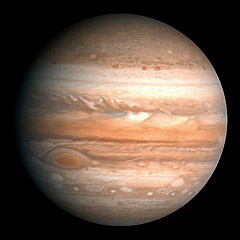 |
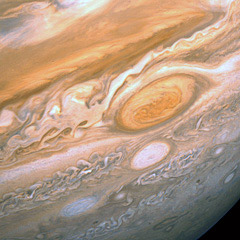 |
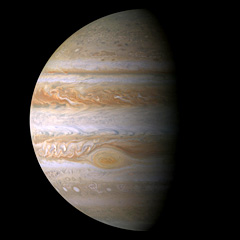 |
||
| Voyager 1 photo of Jupiter (NASA/JPL) |
Voyager 2 close-up of Jupiter cloud features (NASA/JPL) | Cassini spacecraft high resolution mosaic image of Jupiter (NASA/JPL) |
| Back to Previous Stop | Return to Jovian System |
Jupiter | Continue Tour to Europa |
Continue to Next Stop |
King of the Gods
Our first stop in the Jovian system is a truly awesome sight. It is a gaseous planet of enormous proportions. This is the planet Jupiter. It is the fifth planet from the Sun and is the largest. It is also In fact, Jupiter is almost twice the size of all of the other planets combined. Over one thousand Earths could fit inside if it were hollow. Because of its gigantic size, Jupiter was named after the king of the gods in Roman mythology. In Greek mythology, he was known as Zeus, and was famous for hurling lightning bolts at earthbound mortals.
Jupiter is the fourth brightest object in the sky, so it has been known to exist since prehistoric times. It was Galileo who discovered Jupiter's four largest moons, Callisto, Europa, Ganymede, and Io, in 1610. We now know of 79 moons in orbit around Jupiter, ranging in size from just a few miles across to nearly Earth-sized. The Jovian system is like a miniature solar system within a solar system. With so many satellites tugging on Jupiter with their tidal forces, these moons are actually causing Jupiter's rotation to slow down. These same tidal forces are also pushing the moons farther away from the massive planet.
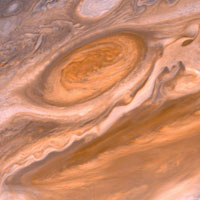 |
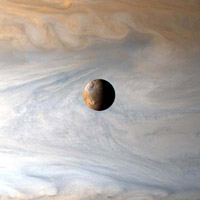 |
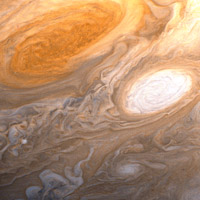 |
||
| Voyager 2 closeup of Jupiter's famous red spot (NASA/JPL) | Galileo image of Jupiter's moon Io (NASA/JPL/University of Arizona) |
Galileo image of Jupiter's moon Io (NASA/JPL/University of Arizona) |
The Famous Red Spot
Perhaps the most famous feature of Jupiter is its giant red spot. This spot is actually a gigantic storm system. This large blemish is a high-pressure region where the winds blow in a counter-clockwise direction at over 250 miles (402 km) per hour. The cloud tops are much higher and colder than the surrounding clouds. This accounts for the spot's darker color. With a diameter of more than 16,000 miles (25,000 km), this storm is twice the size of the Earth! Many spots and colorful bands appear and disappear in Jupiter's turbulent atmosphere, but the great red spot has been know to exist for more than 300 years. Astronomers do not yet know what forces have kept this storm together for so long. And nobody knows just how much longer it will last.
Spots of a different kind were seen in 1994 when a comet named Shoemaker-Levy 9 smashed into the planet. The comet had broken into 21 separate fragments as a result of a close encounter with Jupiter's massive gravitational forces. On July 16 1994, for seven days, these fragments bombarded the giant planet. The impacts left monstrous black scars on the Jupiter's surface. Explosive plumes several times the size of Earth were observed, and the dark scars remained visible on the planet for nearly a year. It was one of the most watched astronomical events in history, and it proved once and for all that comets do hit planets.
 |
| Mosaic image created by the Cassini spacecraft showing details of Jupiter's cloud bands. The great red spot can be seen in addition to several other storms visible as smaller round spots.(NASA/JPL) |
Features of Jupiter
Jupiter has amazed and intrigued astronomers for centuries. It has been visited by a total of six spacecraft, including the current Galileo mission. In 1995, Galileo dropped a probe into Jupiter's atmosphere. The probe took measurements and gave us our first clues as to what was inside Jupiter's thick atmosphere. With this data, and data collected on previous missions, we now know that Jupiter is essentially a gigantic ball of gas. The planet is composed mainly of hydrogen, with helium and traces amounts of other gases. One surprising find was that there is much less water in Jupiter's atmosphere than previously expected. Astronomers believe that Jupiter has no solid surface. Instead the gases get thicker and denser as they get closer to the planet's center. The extreme pressure at Jupiter's core compresses the hydrogen into a rare liquid metallic state. The planet may also have a small, rocky core about 10 times the size of Earth.
Jupiter's outer atmosphere is extremely dynamic. Colorful bands and spots can be see rotating and changing regularly. The colors in the bands are believed to be the result of chemical reactions in the atmosphere. The Galileo probe measured wind speeds exceeding 400 miles (643 km) per hour.
A big surprise revealed by the Voyager 1 spacecraft was that Jupiter has rings, much like Saturn. But unlike Saturn's rings, Jupiter's rings are very delicate and simple. These rings are divided into three main segments, and were not known to exist prior to Voyager's discovery because they are too thin to be seen from Earth.
One other item in Jupiter's long list of oddities is its magnetic field. It is so strong that is actually extends past the orbit of Saturn. In fact, it is 4000 times stronger than Earth's magnetic field. Even stranger still is the fact that Jupiter's rotation is so fast - only 9.8 Earth hours - that the planet actually bulges out in the center. A close examination of any Jupiter photo will reveal that the planet is more oval shaped than round.
The Sun
Mercury
Venus
Earth
Mars
Jupiter
Saturn
Uranus
Neptune
Pluto
Asteroids
Comets
Interstellar Space
Your Weight on Other Planets
|
||||||||
The Moons of Jupiter |
||||||
Name |
Pronunciation |
Order |
Diameter |
Orbital Period |
Distance |
Year |
|
Themisto Ersa Pandia Dia Carpo S/2003 J12 Valetudo Euporie Eupheme S/2003 J18 S/2010 J2 Thelxinoe Euanthe Helike Orthosie S/2017 J7 S/2016 J1 S/2017 J3 Iocaste S/2003 J16 Praxidike Harpalyke Mneme Hermippe Thyone S/2017 J9 Herse Aitne S/2017 J6 S/2011 J1 Kale Taygete S/2003 J19 Chaldene Philophrosyne S/2003 J10 S/2003 J23 Erinome Aoede Kallichore S/2017 J5 S/2017 J8 Kalyke Callirrhoe Eurydome S/2017 J2 Pasithee S/2010 J1 Kore Cyllene S/2011 J2 Eukelade S/2017 J1 S/2003 J4 Hegemone Arche Isonoe S/2003 J9 Eirene Sponde Autonoe Megaclite S/2003 J2 |
MEE-tis a-DRAS-tee-uh am-al-THEE-uh THEE-bee EYE-oh yur-ROH-pah GAN-ee-meed kah-LISS-toe them-ISS-toe LEE-duh him-MAH-lee-uh ER-suh Pan-DEE-uh ly-SITH-ee-uh ee-LAH-ruh DY-uh KAR-poh - val-ee-TOO-doh yoo-POR-ee - - - thelk-SIN-o-ee yoo-AN-thee hee-LIKE or-THOH-see - - - EYE-o-KAS-tee - prak-SID-uh-kee har-PAL-uh-kee NEE-mee her-MIP-ee thye-OH-nee - a-NANG-kee HUR-see et-NEE - - KAY-lee tay-IJ-uh-tee - kal-DEE-nee fee-law-fraw-SEE-nee - - err-RIN-o-mee ay-EE-dee kuh-LIK-o-ree - - KAL-uh-kee KAR-mee ka-LIRR-oh-ee yoo-RID-uh-mee - pah-SITH-uh-thee - KOHR-ee suh-LEE-nee - ew-KEL-uh-dee - - pah-SIF-uh-ee huh-JEM-uh-nee ARK-ee eye-SON-oh-ee - eye-REEN sy-NOH-pee SPON-dee aw-TON-o-ee meg-uh-KLY-tee - |
1 2 3 4 5 6 7 8 9 10 11 12 13 14 15 16 17 18 19 20 21 22 23 24 25 26 27 28 29 30 31 32 33 34 35 36 37 38 39 40 41 42 43 44 45 46 47 48 49 50 51 52 53 54 55 56 57 58 59 60 61 62 63 64 65 66 67 68 69 70 71 72 73 74 75 76 77 78 79 |
60×40×34 20×16×14 250×146×128 116×98×84 3,643 3,122 5,262 4,821 8 16 170 2 2 36 86 4 3 1 1 2 2 2 1 2 3 4 2 2 3 2 5 2 7 4 2 4 4 2 28 2 3 2 1 2 5 2 4 2 2 2 3 4 2 2 1 5 46 9 3 2 2 2 2 2 1 4 2 2 60 3 3 4 1 4 38 2 4 5 2 |
7h 4m 29s 7h 9m 30s 11h 57m 23s 16h 11m 17s 1.769 3.551 7.154 16.689 129.87 240.82 250.23 250.4 251.77 259.89 259.64 287.93 458.62 -482.69 532 -538.78 -561.52 -587.38 -588.36 -597.61 -598.09 -601.40 -602.62 -602.77 -603.83 -605,76 -609.43 -610.36 -613.90 -24.54 -627.48 -629.81 -639.80 -640.90 -640.38 -672.75 -679.64 -684.66 -694.98 -685.32 -686.67 -698.55 -699.33 -699.68 -700.13 -700.54 -711.96 -714.66 -717.81 -720.49 -720.73 -721.02 -721.82 -722.62 -723.36 -723.83 -726.93 -724.34 -723.72 -731.10 -731.32 -735.20 -734.15 -739.29 -739.80 -745.50 -746.19 -750.13 -752.84 -758.34 -739.33 -771.60 -772.17 -792.44 -981.55 |
127,690 128,690 181,366 221,889 421,700 671,034 1,070,412 1,882,709 7,393,216 11,187,781 11,451,971 11,453,004 11,494,801 11,740,560 11,778,034 12,570,424 17,144,873 17,739,539 18,928,095 19,088,434 19,621,780 20,219,648 20,307,150 20,453,753 20,464,854 20,540,266 20,567,971 20,571,458 20,595,483 20,639,315 20,722,566 20,743,779 20,823,948 21,063,814 21,129,786 21,182,086 21,405,570 21,429,955 21,454,952 22,134,306 22,285,161 22,394,682 22,401,817 22,409,207 22,438,648 22,696,750 22,713,444 22,720,999 22,730,813 22,739,654 22,986,266 23,044,175 23,111,823 23,169,389 23,174,446 23,180,773 23,197,992 23,214,986 23,230,858 23,240,957 23,307,318 23,314,335 23,345,093 23,396,269 23,400,981 23,483,694 23,483,978 23,570,790 23,609,042 23,702,511 23,717,051 23,800,647 23,857,808 23,973,926 24,057,865 24,252,627 24,264,445 24,687,239 28,570,410 |
1979 1979 1892 1979 1610 1610 1610 1610 1975/2000 1974 1904 2018 2017 1938 1905 2001 2003 2003 2016 2002 2003 2003 2010 2003 2002 2003 2002 2017 2016 2017 2001 2003 2001 2001 2003 2002 2002 2017 1951 2003 2002 2017 2011 2002 2001 2003 2001 2003 2003 2004 2001 2003 2003 2017 2017 2001 1938 2000 2002 2017 2002 2010 2003 2003 2011 2003 2017 2003 1908 2003 2002 2001 2003 2003 1914 2002 2002 2001 2003 |
| Back to Previous Stop | Return to Jovian System |
Return to Top of Page |
Continue to Next Stop |



